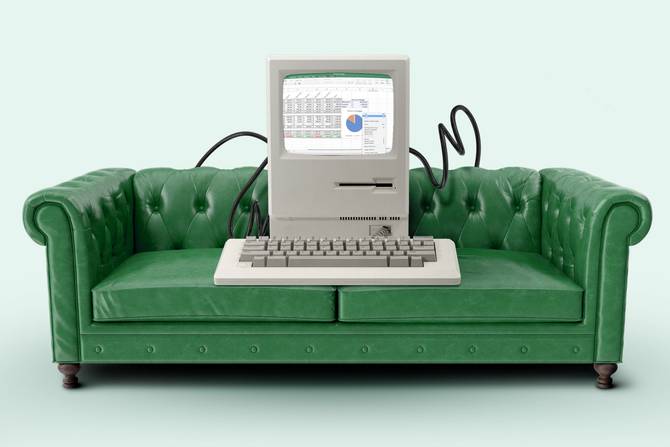Happy Tuesday, readers! Are you particularly proud of your workspace? Click here to brag about the ergonomic chair that took you weeks to find, the novelty mouse pad you picked up on that vacation of a lifetime, and all the precious tchotchkes that keep you company.
In today’s edition:
 We’re all winners We’re all winners
 The more you know The more you know
🧊 Put it on ice
—Sam Blum, Kristen Parisi, Sam Klebanov
|
|
Constantine Johnny/Getty Images
Prior to 2021, companies could conceal salary bands like exotic treasures locked behind a vaulted door. However, legislators have recently pried the doors open, passing a series of salary transparency laws in various states and districts. Many of the new rules, notably in the large employment hubs of New York City and California, mandate that employers list once-guarded salaries on all job listings as a matter of routine compliance.
Widespread transparency laws have been lauded as potentially transformational for job-seekers. Research indicates that the legislation could chip away at generations of gender and racial wage inequalities, and tens of millions of candidates no longer have to guess what kind of salary package might materialize at the end of an interview process.
But the incentives for companies to publicly disclose salary bands extend far beyond evading government penalties, two sources explained to HR Brew. When employers are transparent, it increases employee trust, said Jamie Coakley, SVP of people at the IT support firm Electric. On the other hand, “For companies that do have equality issues or pay disparity, this can be a really scary time,” she told HR Brew.
Part of building trust, and the recruitment pipeline, involves posting salary ranges that actually help candidates, instead of comically gargantuan bands. “Companies don’t budget like that,” Coakley said. “They don’t say, ‘We might hire a product manager next year for $60,000 or $300,000.’” But listing salary ranges in good faith can offer the dual benefit of fostering candidate trust in a company and ensuring that job-seekers won’t be surprised when an offer comes down the pike. Keep reading here.—SB
Do you work in HR or have information about your HR department we should know? Email [email protected]. For completely confidential conversations, ask Sam for his number on Signal.
|
|
|
Not knowing how your employees feel is like being at a silent disco—everyone’s in their own bubble, and you don’t know who’s happy dancing or who’s…rage dancing.
Employee sentiment has a huge impact on employee churn, job satisfaction, and company culture. That’s why it’s so important to measure it à la workforce listening solutions.
Workday’s latest infographic shows insight from 200 executives on how these solutions improve employee engagement, productivity, and inclusivity. Spoiler: 77% agree that deeper insight into employee sentiment would enhance the employee experience and journey.
Here’s another spoiler: Intentional connection is very low-key atm. Only 17% of companies are surveying employees on (at least) a quarterly basis.
Ready to put the pieces together? Check out the infographic.
|
|
Cjmacer/Getty Images
It’s 1906. White-collar workers are comparing fashionable canes, the Model K is the hot new car, and somewhere in California, inventor Luther Haws is busy fiddling with an invention that will change the workplace—and gossip—forever.
History lesson. Haws invented the first drinking fountain in 1906 after learning that the communal tin cups shared by school children were a breeding ground for germs. In 1938, he released an upgrade—a self-contained electric water cooler—just in time for the first open-office space to be unveiled in 1939.
The water cooler (or bubbler, for the Bostonians among us) provided workers a place to congregate, regardless of their position at a company. By the 1960s, most offices had water coolers, tucked away from view of visiting clients and customers in a breakroom, according to Inverse.
“The beauty of the water cooler is that it brings together people who otherwise wouldn’t have a reason to talk,” said Bradley Brummel, professor of psychology at the University of Tulsa, in a Korn Ferry blog post.
Virtual water coolers. Decades of research have shown the positive effects of water cooler talk, so it’s no surprise that HR and workplace culture leaders have tried to digitize the experience for the current age of remote work. Keep reading here.—KP
Do you work in HR or have information about your HR department we should know? Email [email protected]. For completely confidential conversations, ask Kristen for her number on Signal.
|
|
Hannah Minn
Wondering why your economist friends spent Friday partying like it was 1999? The Bureau of Labor Statistics released its monthly jobs report, and as Morning Brew’s Sam Klebanov recently reported, it inspired some cautious optimism.
[The] number that really got people talking was the lower-than-expected month over month wage growth, which slowed to 0.3% in December and 4.6% annually.
While that might not sound like welcome news to anyone who doesn’t live off a fortune inherited from their robber baron granddad, the folks at the Federal Reserve are most certainly pleased. Rapidly growing paychecks are seen as one of the key drivers of inflation, which the Fed has been trying to tame with aggressive interest rate hikes since early last year.
Economists have dubbed the jobs data a “Goldilocks” situation—not too hot, and not too cold. Since both the labor shortage and the strident wage growth it drove seem to be abating, the hope is that inflation will continue to decline. At the same time, a strong labor market (fingers crossed) might just allow the economy to avoid a recession caused by the interest rate increases.
Keep reading on Morning Brew.—SK
|
|
Today’s top HR reads.
Stat: Some 31% of employees say their employer does not penalize those who WFH on days when they’re asked to be in the office. (Harvard Business Review)
Quote: “Today is better than it’s going to be six months from now…So, I would try to make your moves as soon as possible.”—Andy Challenger, SVP at outplacement firm Challenger, Gray & Christmas, on why job-seekers shouldn’t wait to make a change (CNBC)
Read: Betsey Stevenson, former chief economist for the US Labor Department, shares takeaways from the latest round of employment data. (University of Michigan)
|
|
Giphy
|
As an HR professional, it pays to be one step ahead of the constantly evolving industry. With the Brew’s Business Essentials Accelerator, you can accelerate your talent strategy by understanding the roles everyone in your biz plays. Apply here.
|
|
-
HR departments are grappling with differing opinions on how to conduct layoffs.
-
Goldman Sachs is expected to start laying off thousands of employees this week.
-
The SEC has charged McDonald’s for “misrepresenting” the firing of its former CEO.
-
The NBA hired HP’s Lesley Slaton Brown to be its chief diversity officer.
|
|
Catch up on the top HR Brew stories from the recent past:
|
|
|







.gif)
